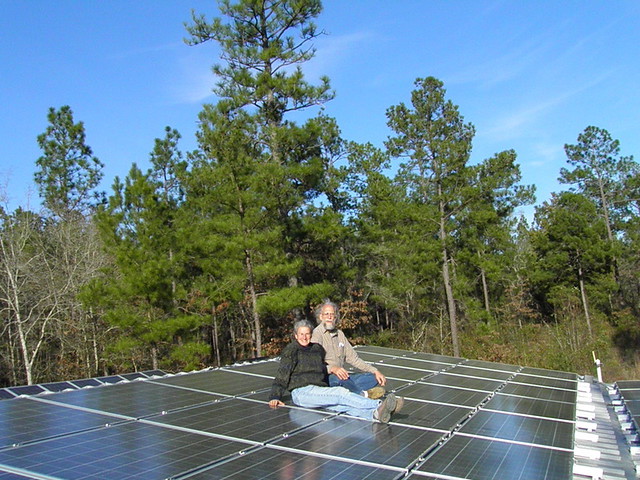Weeding and plowing:
Gretchen Quarterman, Terry Davis, Lowndes County, Georgia, 14 March 2012.Pictures by John S. Quarterman for Okra Paradise Farms.
Plowing:
Continue reading
Weeding and plowing:
Gretchen Quarterman, Terry Davis, Lowndes County, Georgia, 14 March 2012.
Plowing:
Continue reading
Landscape:
Pictures by John S. Quarterman, Lowndes County, Georgia, 21 March 2012.
Yes, Brown Dog and Yellow Dog found another hog-nosed snake. Hiding:
Boxed:
In hand:
On ground:
 What is it with Moody and the cargo planes lately? Are they that fascinated with our solar panels?
What is it with Moody and the cargo planes lately? Are they that fascinated with our solar panels?
Here’s the video:
Moody cargo plane overhead
John S. Quarterman, Gretchen Quarterman,
Brown Dog, Yellow Dog,
Lowndes County, Georgia, 7 March 2012.
Video by Gretchen Quarterman
-jsq
Yellow Dog and Brown Dog pointing:
Pictures by John S. Quarterman for Okra Paradise Farms.
Can you see it there, between the wiregrass and the oak log?
High and higher:
Lowndes County, Georgia, 7 March 2012.
Pictures by Gretchen Quarterman for Okra Paradise Farms
Closeup:
Continue reading
Daniel Charles wrote for The Salt 11 March 2012, Why Monsanto Thought Weeds Would Never Defeat Roundup,
First, the company had been selling Roundup for years without anySo they thought small scale would be the same as saturating 90+% of every corn, soybean, peanut, and cotton field in the U.S. and numerous other countries with virulent poisons. Because they wanted the money.problems. Second, and perhaps most important, the company’s scientists had just spent more than a decade, and many millions of dollars, trying to create the Roundup-resistant plants that they desperately wanted — soybeans and cotton and corn. It had been incredibly difficult. When I interviewed former Monsanto scientists for my book on biotech crops, one of them called it the company’s “Manhattan Project.”
Considering how hard it had been to create those crops, “the thinking was, it would be really difficult for weeds to become tolerant” to Roundup, says Rick Cole, who is now responsible for Monsanto’s efforts to deal with the problem of resistant weeds.
-jsq

Photo CC BY-ND Okra Paradise Farms
You can see the old panels sticking up on the left, and we’re sitting on some of the new panels, which continue on the lower roof on the right.
 These panels were purchased with the assistance of a
USDA Rural Energy for America Program (REAP) 25% grant:
These panels were purchased with the assistance of a
USDA Rural Energy for America Program (REAP) 25% grant:
Eligible projects include those that derive energy from a wind, solar, biomass, or geothermal source, or hydrogen derived from biomass or water using wind, solar, or geothermal energy sources.The REAP program will probably be renewed this year, so if you have a farm, you could apply.
 We also applied for and got a
We also applied for and got a
 U.S. Treasury 30% grant from the
1603 Program: Payments for Specified Energy Property in Lieu of Tax Credits.
That program was funded by the
The American Recovery and Reinvestment Act of 2009 (Recovery Act).
U.S. Treasury 30% grant from the
1603 Program: Payments for Specified Energy Property in Lieu of Tax Credits.
That program was funded by the
The American Recovery and Reinvestment Act of 2009 (Recovery Act).
Finally, there is the Georgia Environmental Finance Authority (GEFA) 35% Clean Energy Property Tax Credit, which will apply in parts over four years.
That all adds up to 90% covered by grants and tax credits, which is a pretty good deal.
Now that remaining 10% is still a significant amount;
like the price of a small car.
But in 7-15 years (how long it will take to pay off this system,
depending on how you figure it),
what would
 the value of a car be?
Much less than when you bought it.
Meanwhile, these solar panels will be generating almost as much
power as they are now, and they will continue to generate for
at least a decade more, probably much more.
the value of a car be?
Much less than when you bought it.
Meanwhile, these solar panels will be generating almost as much
power as they are now, and they will continue to generate for
at least a decade more, probably much more.
The big missing piece is up-front financing. For more on that, see other blog post.
Meanwhile, we have here on our workshop roof a proof of concept, operational right now.
The little dogs wanted to know what we were doing on the roof: Continue reading